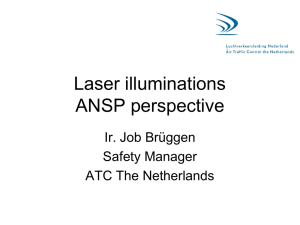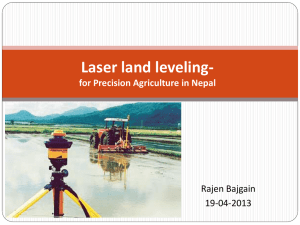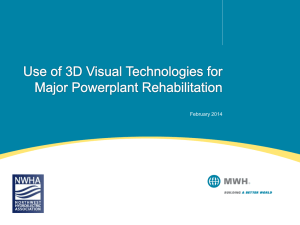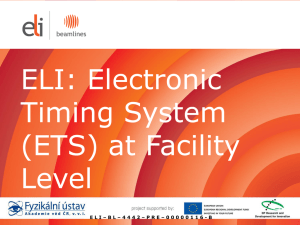Eli
advertisement
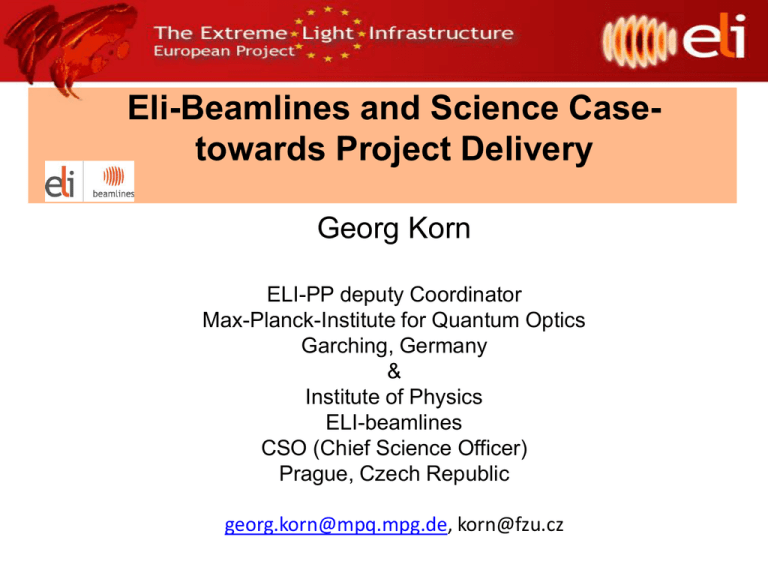
Eli-Beamlines and Science Casetowards Project Delivery Georg Korn ELI-PP deputy Coordinator Max-Planck-Institute for Quantum Optics Garching, Germany & Institute of Physics ELI-beamlines CSO (Chief Science Officer) Prague, Czech Republic georg.korn@mpq.mpg.de, korn@fzu.cz UHIP-ELI and ELI Virtual Institute The ELI-central laser facility will finally allow to go to the ultra-relativistic interaction regime, Peak-Power 200 PW - the dream www.eli-laser.eu • 300 projects submitted Social. Sciences Energy Environmental sciences Biomedical and life sciences Material sciences (ELI) Astronomy, Astrophysics, nuclear and particle Physics • > 35 accepted (peer rev.) • ELI 14 p. out of 15 p. scored very highly and was put on the European Roadmap for Research Infrastructures ELI-PP Start November 2007 End December 2010 13 countries on board: CZ, Hu, Ro, Fr, Ge, UK, I, Lith., Gr, Pl Sp, Bu, Po Initial EU funding 6 Mio € to facilitate: science program develop. technical design (TDR) safety&radioprotection site choice legal structure governance financial planning funding Site selection: decision on 1.10.2009 Czech Republic Prague Overall cost: 750M€ Hungary Szeged Romania Bucharest - Magurele (Legal) Implementation of ELI DC-Delivery Consortium signed Next step Single governance, three-site research infrastructure: ELI-ERIC (European Research Infrastructure C onsortium) … is to be formed in 2011 ELI/ERIC PanEuropean Beamlines Attolaser CZ Hu High Intensity 2012 Decision on Tech. Nuclear Physics Ro National Projects UK Vulcan, RAL Fr Apollon, ILE Ge PFS, PFSpro MPQ, MBI, CALA, FZD CZ HILASE ELI-PP , Laserlab Europe (> 100 Mio €) 530 pages Science, technology and implementation strategies o f ELI Electron-, Proton- and X-ray Beamlines developments are directly connected with some applications Strong Field Limits in the UltraRelativistic Interaction of Electrons with Electro-Magnetic Waves in Plasmas 4/8/2015 11 Fundamental intensity dependent regimes of interaction Amplitude Intensity é eE 0 ù êa 0 = ú ê m ec w úû ë éW ù ê 2ú êëcm úû 2 aQED = aQM 2e 2m ec = 3h 2 w ap = arad m ec hw mp 1/ 3 ÷÷ö ÷÷ eø arel = 1 5.6 × 10 24 e + , e - in vacuum quantum effects 1.3 × 10 24 ultra - relativistic p me æ 3l = çç çè4p r 2.4 × 10 29 Regime 1× 10 23 radiation damping 1.3 × 1018 relativistic e - e Erel = me c 2 e Eultrarel = m p c ecomp Erel = me c 2 2 comp (electron) 2.4x106 µm Very compact accelerators can be built SUMMARY of Laser-Plasma Interaction in “Radiation-Dominant” Regimes e–-e pair creation in vacuum p Radiation dominant regime Relativistic regime Nonrelativistic regime µ a Currently Imax = 1022 W/cm2 ELI will be pushing the limits by more than 1-2 orders but we have to climbe carfully the int. µ a 1/4 Quantum ElectroDynamics regime3/8 µ a Es= 1320PV/m 1 a = 408 g = 70 MeV c rad a rad aQ aQED Ultrarelativistic ELI a0 > 2000, E= 4 PV/m a Outline of the ELI-Beamlines facility B. Rus, F. Batysta, J. Čáp2, M. Divoký, M. Fibrich, M. Griffiths, R. Haley3, T. Havlicek, J. Hrebicek, P. Homer, P. Hribek, J. Jandourek, L. Juha, G. Korn 4, P. Korouš, M. Košelja, M. Kozlová, D. Kramer, M. Krus, J.C. Lagron 4, J. Limpouch6, L. McFarlane3, M. Malý, D. Margarone, P. Matlas, L. Mindl, J. Moravec 7, T. Mocek, J. Nejdl, J. Novák, V. Olšovcová, M. Palatka 8, J.P. Perin 9, M. Pešlo, J. Polan, J. Prokupek, K. Rohlena, M. Sawicka, L. Scholzová, D. Snopek2, P. Strkula, L. Švéda2 Institute of Physics v.v.i., Prague 8 2ELYA 3Nuclear Solutions s.r.o., Prague 10, Technologies Ltd., 4MPQ Garching, Germany, 5Univ. Paris-Sud, France, 6Czech Technical University, Prague, 7Foton s.r.o., Czech Rep., 8 UPOL Olomouc, Czech Rep., 9 SBT-CEA Grenoble, France Project background and status ELI-Beamlines: one of the designed ELI pillars ELI-ALPS, Hu ELI-Beamlines, Cz ELI-NP, Ro Site to be determined High-intensity development Attosecond XUV/X-ray physics Applications in material sciences and biology High-brightness sources of X-rays & particles Molecular & biomedical sciences, particle acceleration, dense plasma physics, exotic physics Laser-induced nuclear physics Photonuclear science and applications Exawatt-class laser technology High-intensity laser technologies for frontier physical research ELI-Beamlines mission, Prague 1. Generation of femtosecond secondary sources of radiation and particles - XUV and X-ray sources (monochromatic and broadband); plasma based x-ray lasers and amplified HHG (100 µJ – 10 mJ) - Accelerated electrons (2 GeV 10 Hz rep-rate, >10 GeV low rep-rate), protons ( trying to enter 50-70 MeV 10 Hz rep-rate, >1 GeV low-rep-rate) - ELI Betatron beamline - preparation for a future laser driven, LUX and later X-FEL - Gamma-ray sources (broadband); entering the radiation driven regime 2. Programmatic applications of the femtosecond secondary sources - Medical research including proton therapy (1 PW-Laser, 10 Hz), detectors time, spat. res. - Molecular, biomedical and material sciences - Physics of dense plasmas, WDM, laboratory astrophysics (radiographic images) 3. High-field physics experiments with focused intensities 1022-1024 Wcm-2 - Exotic plasma physics (e.g. electron-positron pair plasma), non-linear QED proton and electron acceleration at high intensities and high energies, careful studies of different intensity regimes, proof of achieved intensities and the corresponding interaction 4. Participation in prototyping technologies for the high-intensity pillar Compression & coherent superposition of multi-10-PW ultrashort pulses (>100 PW far future) Science Case in the ELI-Beamline ELI-Beamlines bid: balance between fundamental science and applications ELI-Beamlines will be international user facility, partnership experiments & projects Research Program 1 Lasers generating rep-rate ultrashort pulses & multi-petawatt peak powers Research Program 2 X-ray sources driven by rep-rate ultrashort laser pulses, Research Program 3 Particle acceleration by lasers Research Program 4 Applications in molecular, biomedical, and material sciences Research Program 5 Laser plasma and high-energy-density physics (PALS kJ laser synchronized to 40 TW laser) Research Program 6 High-field physics and theory (steps to 1023W/cm2, radiation reaction plays role) ELI Beamlines budget and steps towards funding Total investment: 265 mil. Euro, Structual funds (85% EU, 15%-State) Timeline: Nov 12, 2009 Submission of ELI-Beamlines bid into the national funding call (“Research & Development for Innovations”) Feb 2010 ELI-Beamlines bid assessed by the national expert panel (industrial applications, national synergies, financial sustainability) March 19, 2010 ELI-Beamlines bid assessed by the international expert panel (quality of research, quality of management, human resources strategy) May 20, 2010 National negotiations on funding successfully concluded June 28, 2010 Project receives OK note by JASPERS (Joint Assistance to Support Projects in European Regions) June 30, 2010 Request for funding submitted to EC Sept 13, 2010 Construction permit to build ELI-Beamlines issued Dec 2010 Project approved by EC’s DG Research, DG Regio and DG Environ, additional issues raised by DG Competition Feb 2011 Project approved by EC’s DG Competition April 20, 2011 final Note of Approval from the EC !!! ELI-Beamlines location: South of Prague • Proximity of international airport (15 min drive), enjoyable surroundings, behind the border of Prague (funding issuses) • Synergy with planned large biotechnology center BIOCEV (2 km distance) • Direct connection to Prague outer ring and the European motorway network (4 hours to Berlin, 3.5 hours to Munich, 1.5 hours to Dresden ) ELI Beamlines construction: timeline June 2011 Technical Design Report /Readiness 1, involving full WBS and PBS July 2011 Start of oscillator and front end development & testing Sept 2011 Construction documentation completed Oct 11 Site preparatory works start end 2011 Agreements with main partners in development of laser systems 2011 – 2014 2013 – 2014 Prototyping & testing lasers, beam delivery, compressors, etc. subsystems Pre-assembly of selected systems Feb 2012 Technical Design Report /Readiness 2 March 2012 Construction works start end 2013 Technical Design Report /Readiness 3 April 2014 Commissioning of the ELI-Beamlines building incl. cleanrooms May 2014 Start of installation of lasers and beam delivery systems July 2015 Laser and experimental hardware installed Dec 2015 Commissioning of selected laser systems and experimental areas for users 2. Laser and experimental facilities ELI Beamlines facility laser Laser system Exp. areas Technologies of rep-rate pump lasers for ELI-Beamlines Thin disk pump technology Multislab pump technology Development at MPQ/LMU/MBI ELI: cooperation on scaling to >kW avg power 0.5 kW 1.5ps, 3kHz LLNL - Mercury 60J/10Hz, Development of cryogenic Yb:YAG at RAL ELI: cooperation on dev’t of 500 J/10 Hz cryogenic amps, HILASE Design of 25 kW head Compressor (negative GDD) (Uni Jena 1400 Lines/mm): Bandwidth nm GDD Efficiency Pulse duration Pulsenergie ~1 nm @ 1030 ~ -108 fs² ~ 77 % 1,6 ps 25,0 mJ 0.5 kW ; 1J-2 J, 1 kHz staging for pumping the OPCPA, 1 kHz, Common effort, MPQ, court.T. Metzger Modelling of ASE losses and energy budget in multislab lasers Design phase of 500 J/ 10 Hz multislab amplifiers (collaboration with Rutherford Appleton Laboratory) E3 Baseline model E2 E1 ASE pump Heat sources in the crystal: - Transition (>11 %): Stokes defect Quantum efficiency (non-radiative) - 8 Yb:YAG slabs, each 8 mm thick Nominal operation temp. 170K Radiative (>35 %) Absorption on impurities Absorption on the ASE absorber Higher orders effects (colective absorption) - ASE losses can be limited by MLD absorptive coating or Cr:YAG absorber - Heat conduction calculations predict < 4 K temperature non-uniformity M. Divoký et al. Numerical evaluation of heat deposition in cryogenically cooled multi-slab amplifier Concept for 1 kJ DPSSL Amplifier, RAL design HILASE, HIPER • Beam size 14 x 14 cm2 5 J/cm2 extraction fluence (safe?) • 2 Amplifier heads • Pump 5kW/cm2 each side for 1 ms • Dpump = 5 nm, c,pump = 939 nm • Combined pump power 4 MW need to reach 25% o-o efficiency • 175 Kelvin (or lower) • 12 slabs, variable doping • ASE control: go*l < 3 along diagonal HiLASE project Institute of Physics AS CR 30 M € Diode pumped Lasers for applications New lasers for industry and research ● High average power pulsed LASErs ● Czech national project on development of advanced solid-state laser technologies based on diode pumping ● Motivated by strong need for head-start laser technology development & prototyping for the next generation of high rep. rate laser facilities ● Potential of industrial applications using rep. rate, high-peak and highaverage power lasers ● Implementation phase: 4 years (fully supported) ● Operational phase: ALAP (institutional/grants/contractual) Electron acceleration (LWFA) with 250 J laser pulses Luis Silva, IST Lisbon, ELI-Beamlines Scientific Challenges Workshop, Prague 26-27 April, 2010 “Long” pulses (>100fs) required for e- acceleration! 10 PW pump lasers (1st floor) If available, disk lasers providing kJ energy and bandwidth >12 nm (~130 fs pulses) would be an excellent choice for e- acceleration! Back up for OPCPA ELI-Beamlines layout First floor 10 PW pump lasers Cryogenic & thermal management support systems Ground floor Laser systems Basement Compressor hall of 10-PW beamlines Pulse distribution 6 dedicated experimental areas 10 PW pump lasers Cryogenic systems, power supply cooling, auxiliary systems Oscillator & Front end 50 J / 10 Hz beamlines 10 J / 10 Hz beamlines Broadband 10 PW amps Potential future 3D diffractive imaging of complex molecules Plasma physics Material & biomolecular applications 10 PW optical compressors All laser systems shown, including those which might be located at the facility in future X-ray sources: plasma x-ray laser (seeded), k-alpha, Exotic Physics Betatron X-ray sources p+ acceleration e- acceleration Potential future laser driven FEL cooperation with accelerator people ( important ) ELI-Beamlines mission, x-ray Betatron, ELI-white book Applications: 3D phase or absor. contrast imaging possible with different projections High spatial coherence ELI-Beamlines mission ELI Betatron beamline 100 TW- 1 PW, ELI- white book S. Kneip, IC ELI-Beamlines mission Laser driven LUX and x-FEL (F. Grüner) Long term vision, ELI-white book 200 TW -1 PW @ 5-10 Hz Cooperation with DESY using accelerator know-how 2 GeV electrons, 5 keV, short and tunable x-ray pulses, Diagnostics of short bunches Detector development Common team generated From projection images to (almost) 3d structures 3 D diffractive imaging using synchronized ELI x-ray pulses Timing synchronization of 30 fs should allow to go for µm samples diffraction Explosion happens over many ps (Hajdu et al.) E3 and E4 shielded experimental areas in the basement Plasma physics area: x-ray back-lighting (2D) optical and x-ray Schlierenmethods 3D proton imaging Understanding of different interaction regimes in dependens on intensity Underground target areas with shielding Combination of bulk shielding and local shielding (beam dumps) Radiological classification: Control rooms are class R1, accumulated annual dose <1mSv protons 100 MeV / 10 Hz electrons 2-3 GeV / 1 nC / 10 Hz 50 GeV / 1.5 nC / <0.1 Hz gamma-rays 175 MeV / 4 Sv electrons 10 GeV / 2 nC protons 200 MeV / 10 Hz 3 GeV / <0.1 Hz Vibration analysis of the laser building Master structural model Monolithic structure (laser and experimental areas) Supporting technologies (air conditioning, vacuum pumps, etc.) & auxiliary laboratories The analysis accounts for actual sources of vibration measured on the site Development works steps - Laser - Complete System integration including target areas - proof of principle experiments showing the anticipated laser power and intensity parameters in the different research areas - user facility mode for different research areas step by step Thank you for your attention and for the kind invitation ! For more info about the ELI Beamlines facility see http://www.eli-beams.eu




